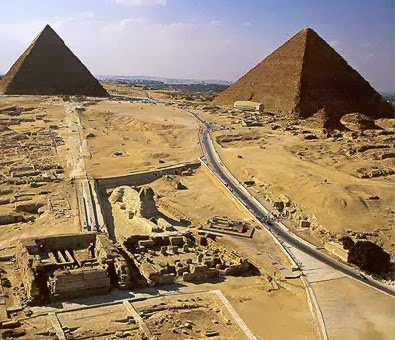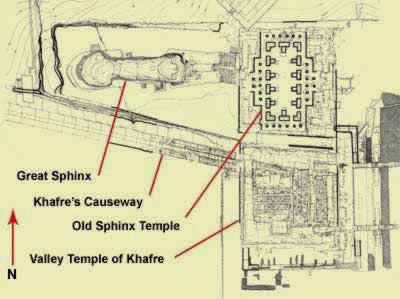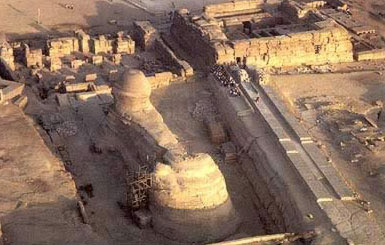In a depression to the south of Khafre's pyramid at Giza near Cairo sits a huge creature with the head of a human and a lion's body. This monumental statue, the first truly colossal royal sculpture in Egypt, known as the Great Sphinx, is a national symbol of Egypt, both ancient and modern. It has stirred the imagination of poets, scholars, adventurers and tourists for centuries and has also inspired a wealth of speculation about its age, its meaning, and the secrets that it might hold.
The word "sphinx", which means 'strangler', was first given by the Greeks to a fabulous creature which had the head of a woman, the body of a lion and the wings of a bird. In Egypt, there are numerous sphinxes, usually with the head of a king wearing his headdress and the body of a lion. There are, however, sphinxes with ram heads that are associated with the god Amun.
The Great Sphinx is to the northeast of Khafre's (Chephren) Valley Temple. Where it sits was once a quarry. We believe that Khafre's workers shaped the stone into the lion and gave it their king's face over 4,500 years ago. Khafre's name was also mentioned on the Dream Stele, which sits between the paws of the great beast. However, no one is completely certain that it is in fact the face of Khafre, though indeed that is the preponderance of thought. Recently, however, it has been argued that Khufu, builder of the Great Pyramid, may have also had the Great Sphinx built.
The Great Sphinx is believed to be the most immense stone sculpture in the round ever made by man. However, it must be noted that the Sphinx is not an isolated monument and that it must be examined in the context of its surroundings. Specifically, like many of Egypt's monuments, it is a complex which consists not only of the great statue itself, but also of its old temple, a New Kingdom temple and some other small structures. It is also closely related to Khafre's Valley Temple, which itself had four colossal sphinx statues each more than 26 feet long.
The material of the Sphinx is the limestone bedrock of what geologists call the Muqqatam Formation, which originated fifty million years ago from sediments deposited at the bottom of sea waters that engulfed northeast Africa during the Middle Eocene period. An embankment formed along what is now the north-northwest side of the plateau. Nummulites, which are small, disk-shaped fossils named after the Latin word for 'coin', pack the embankment. These were once the shells of now extinct planktonic organisms. There was a shoal and coral reef that grew over the southern slope of the embankment. Carbonate mud deposited in the lagoon petrified into the layers from which the ancient builders, some fifty million years later, carved out the Great Sphinx.
To do so, they trenched out a deep, U-shaped ditch that isolated a huge rectangular bedrock block for carving the Sphinx. This enclosure is deepest immediately around the body, with a shelf at the rear of the monument where it was left unfinished and a shallower extension to the north where important archaeological finds have been made.
The good, hard limestone that lay around the Sphinx's head was probably all quarried for blocks to build the pyramids. The limestone removed to shape the body of the beast was evidently employed to build the two temples to the east of the Sphinx, on a terrace lower than the floor of the Sphinx enclosure, one almost directly in front of the paws, the other to the south of the first one.
It is generally thought that quarrying around the original knoll revealed rock that was too poor in quality for construction. Therefore, some visionary individual conceived of the plan to turn what was left of the knoll into the Sphinx. However, the Sphinx may equally well have been planned from the start for this location, good rock or bad. The walls of the Sphinx enclosure are of the same characteristics as the strata of the Sphinx body and exhibit similar states of erosion.
The bedrock body of the Sphinx became a standing section of the deeper limestone layers of the Giza Plateau. The lowest stratum of the Sphinx is the hard, brittle rock of the ancient reef, referred to as Member I. All of the geological layers slope about three degrees from northwest to southeast, so they are higher at the rump of the Sphinx and lower at the front paws. Hence, the surface of this area has not appreciably weathered compared to the layers above it.
Most of the Sphnix's lion body and the south wall and the upper part of the ditch were carved into the Member II, which consists of seven layers that are soft near the bottom, but become progressively harder near the top. However, the rock actually alternates between hard and soft. The head and neck of the Great Sphinx are made of Member III, which is better stone, though it becomes harder further up.
The Sphinx faces the rising sun with a temple to the front which resembles the sun temples which were built later by the kings of the 5th Dynasty. The lion was a solar symbol in more than one ancient Near Eastern culture. The royal human head on a lion's body symbolized power and might, controlled by the intelligence of the pharaoh, guarantor of the cosmic order, or ma'at. Its symbolism survived for two and a half millennia in the iconography of Egyptian civilization.
The head and face of the Sphinx certainly reflect a style that belongs to Egypt's Old Kingdom, and to the 4th Dynasty in particular. The overall form of his face is broad, almost square, with a broad chin. The headdress (known as the 'nemes' head-cloth), with its fold over the top of the head and its triangular planes behind the ears, the presence of the royal 'uraeus' cobra on the brow, the treatment of the eyes and lips all evidence that the Sphinx was carved during this period.
The sculptures of kings Djedefre, Khafre and Menkaure and other Old Kingdom Pharaohs, all show the same configuration that we see on the Sphinx. Some scholars believe that the Great Sphinx was originally bearded with the sort of formally plaited beard. Pieces of the Sphinx's massive beard found by excavation adorn the British Museum in London and the Cairo Museum. However, it seems to possibly, if not probably be dated to the New Kingdom, and so was likely added at a later date. The rounded divine beard is an innovation of the New Kingdom, and according to Rainer Stadelmann, did not exist in the Old or Middle Kingdom. It may have been added to identify the god with Horemahket.
There is a hole in the top of the head, now filled in, that once provided support for additional head decoration. Depictions of the Sphinx from the latter days of ancient Egypt show a crown or plumes on the top of the head, but these were not necessarily part of the original design. The top of the head is flatter, however, than later Egyptian sphinxes.
The body is 72.55 meters in length and 20.22 meters tall. The face of the sphinx is four meters wide and its eyes are two meters high. The mouth is about two meters wide, while the nose would have been more than 1.5 meters long. The ears are well over one meter high. Part of the uraeus (sacred cobra), the nose, the lower ear and the ritual beard are now missing, while the eyes have been pecked out. The beard from the sphinx is on displayed in the British Museum.
Below the neck, the Great Sphinx has the body of a lion, with paws, claws and tail (curled round the right haunch), sitting on the bedrock of the rocky enclosure out of which the monument has been carved. The enclosure has taller walls to the west and south of the monument, in keeping with the present lie of the land.
When viewed close-up, the head and body of the Sphinx look relatively well proportioned, but seen from further away and side-on the head looks small in relation to the long body (itself proportionally much longer than is seen in later sphinxes). In its undamaged state, the body is likely to have appeared still larger all around in relation to the head, which has not been reduced as much by erosion. The human head is on a scale of about 30:1, while the lion body is on the smaller scale of 22:1. There could be a number of explanations for this discrepancy.
This was, as far as we know, one of the very first of the Egyptian sphinxes, though there is at least one other, attributed to Djedefre, that predates it. The rules of proportion commonly employed on later and smaller examples may not yet have been formulated at the time of the carving of the Great Sphinx of Giza. In any case, the carving of sphinxes was always a flexible formula, to an unusual degree in the context of Egyptian artistic conservatism.
Then again, the Sphinx may have been sculpted to look its best when seen from fairly close by and more or less from the front. There is also the possibility that there was simply insufficient good rock to make the head, where fine detail was required, any bigger. Also, the fissure at the rear of the Great Sphinx may have dictated a longer body, rather than one much too short.
There remains the possibility that the head has been remodeled at some time and thereby reduced in size, but on stylistic grounds alone this is not likely to have been done after the Old Kingdom times in ancient Egypt.
There are three passages into or under the Sphinx, two of them of obscure origin. The one of known cause is a short dead-end shaft behind the head drilled in the nineteenth century. No other tunnels or chambers in or under the Sphinx are known to exist. A number of small holes in the Sphinx body may relate to scaffolding at the time of carving.
The figure was buried for most of its life in the sand. It was King Thutmose IV (1425 - 1417 BC) who placed a stela between the front paws of the figure. On it, Thutmose describes an event, while he was still a prince, when he had gone hunting and fell asleep in the shade of the sphinx. During a dream, the sphinx spoke to Thutmose and told him to clear away the sand. The sphinx told him that if he did this, he would be rewarded with the kingship of Egypt. Thutmose carried out this request and the sphinx held up his end of the bargain. Of course, over time, the great statue, the only single instance of a colossal sculpture carved in the round directly out of the natural rock, once again found itself buried beneath the sand.
In the more modern era, when Napoleon arrived in Egypt in 1798, the Sphinx was buried once more with sand up to its neck, at by this point, we believe the nose had been missing for at least 400 years. Between 1816 and 1817, the Genoese merchant, Caviglia tried to clear away the sand, but he only managed to dig a trench down the chest of the statue and along the length of the forepaws. Auguste Mariette, the founder of the Egyptian Antiquities Service, also attempted to excavate the Sphinx, but gave up in frustration over the enormous amount of sand. He went on to explore the Khafre Valley Temple, but returned to the Great Sphinx to excavate in 1858. This time, he managed to clear the sand down to the rock floor of the ditch around the Sphinx, discovering in the process several sections of the protective walls around the ditch, as well as odd masonry boxes along the body of the monument which might have served as small shrines. However, he apparently still did not clear all the sand.
In 1885, Gaston Maspero, then Director of the Antiquities Service, once again tried to clear the Sphinx, but after exposing the earlier work of Caviglia and Mariette, he also was forced to abandon the project due to logistical problems.
Between 1925 and 1936, French engineer Emile Baraize excavated the Sphinx on behalf of the Antiquities Service, and apparently for the first time since antiquity, the great beast once again became exposed to the elements.
In fact, the sand has been its savior, since, being built of soft sandstone, it would have disappeared long ago had it not been buried for much of its existence.
Nevertheless, the statue is crumbling today because of the wind, humidity and the smog from Cairo. The rock was of poor quality here from the start, already fissured along joint lines that went back to the formation of the limestone millions of years ago. There is a particularly large fissure across the haunches, nowadays filled with cement, that also shows up in the walls of the enclosure in which the Sphinx sits.
Below the head, serious natural erosion begins. The neck is badly weathered, evidently by wind-blown sand during those long periods when only the head was sticking up out of the desert and the wind could catapult the sand along the surface and scour the neck and the extensions of the headdress that are missing altogether now. The stone here is not quite of such good quality as that of the head above.
Erosion below the neck does not look like scouring by wind-blown sand. In fact, so poor is the rock of the bulk of the body that it must have been deteriorating since the day it was carved out of the stone. We know that it needed repairs on more than one occasion in antiquity. It continues to erode before our very eyes, with spalls of limestone falling off the body during the heat of the day.
So, today, much of the work on the Great Sphinx at Giza is not directed at further explorations or excavations, but rather the preservation of this great wonder of Egypt. This is the focus, and while some might even today have the antiquity authorities digging about the monument looking for hidden chambers holding the secrets of Atlantis, that is not likely to happen any time soon.
Hope you you enjoyed reading my post & found it
useful
You may be also interested in












No comments:
Post a Comment